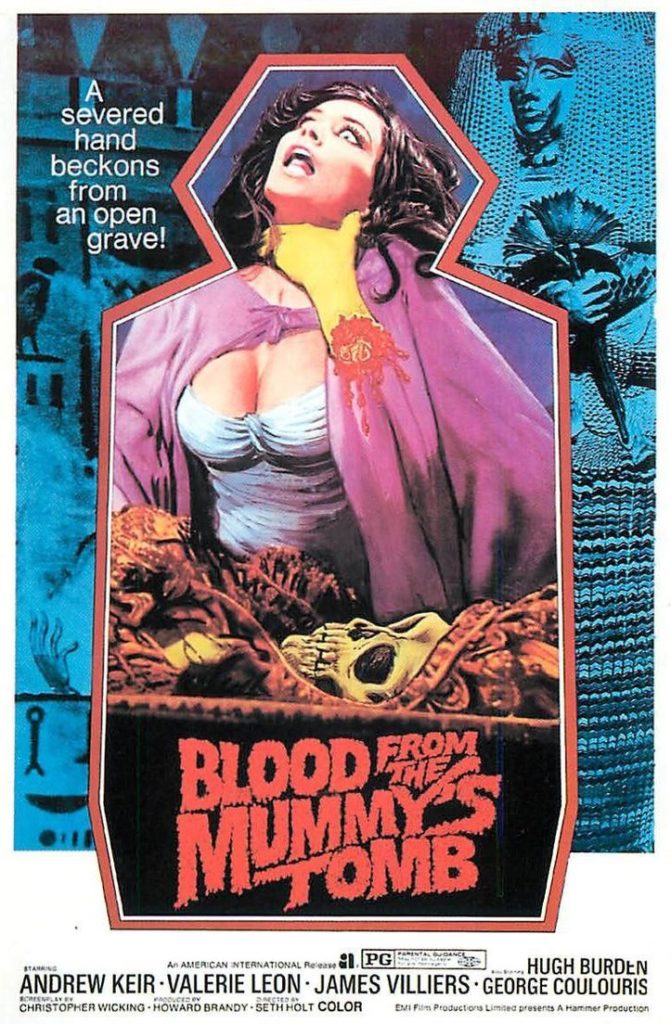 Hammer, in a wise decision, jettisoned much of the tropes they had used in their previous Mummy films. For three consecutive productions, they had made basically the same film. British archaeologists discover ancient Egyptian tomb, said tomb has a curse on it, ancient Egyptian mummy resurrects and kills those who dared desecrate the tomb. It really was the same thing again and again. That was all well and good when they did it the first time, but by the last film, The Mummy’s Shroud, the plot was too familiar, and everyone involved seemed to be just going through the paces.
Hammer, in a wise decision, jettisoned much of the tropes they had used in their previous Mummy films. For three consecutive productions, they had made basically the same film. British archaeologists discover ancient Egyptian tomb, said tomb has a curse on it, ancient Egyptian mummy resurrects and kills those who dared desecrate the tomb. It really was the same thing again and again. That was all well and good when they did it the first time, but by the last film, The Mummy’s Shroud, the plot was too familiar, and everyone involved seemed to be just going through the paces.
The fourth film, Blood from the Mummy’s Tomb, stays true to only some of the core elements, going so far as to ditch the traditional bandages and rags of films past. In this film, written by Christopher Wicking, loosely adapting Bram Stoker’s novel The Jewel of Seven Stars, the mummy is the perfectly preserved corpse of Queen Tera, who died young and buxom, and thus couldn’t be wrapped in bandages, oh no.
Her tomb is discovered by the requisite British Egyptologists, but they bring the dead queen and her artifacts back to England in secret, rather than placing them in a museum or putting on a tour. That’s because, for reasons that are never adequately explained, some of the party wish to resurrect the queen, so she can rule again. Anyway, the resurrection part is kind of on the periphery, because in the meantime, Queen Tera has a doppelganger in Margaret Fuchs (Valerie Leon, who plays both Margaret and Tera), the daughter of the archaeological expedition’s leader, Julian Fuchs (Andrew Keir). She was born in England at the very moment Queen Tera’s sarcophagus was opened, revealing the scantily clad beauty within.
She’s all grown up, now, and determined to figure out why there’s a corpse in her father’s basement that looks just like her. Margaret falls under the sway of another of the expedition’s members, Corbeck (James Villiers), and they set out to gather artifacts from Tera’s tomb that have been taken by other members of the expedition. Along the way, these other members are killed, evocative of mummy’s curses in films past. But, unlike the other films, there is mystery as to who is doing the killing. The expedition members are terrified at the sight of Margaret, due to her resemblance to Queen Tera, but whether or not she is the culprit, or Corbeck, or some other supernatural force, isn’t revealed until the end.
There were some awful production issues plaguing this film. Peter Cushing had been set to star, but had to leave production after the first day of shooting. Meanwhile, the film’s director, Seth Holt, died at age 47 of a heart attack with one week left to shoot. Michael Carreras finished the film. Troubles like that can doom a film, yet cast and crew carried on. Good for them.
In spite of all this, Blood from the Mummy’s Tomb is quite the improvement over where the series had been going. That might have to do with Hammer’s creeping embrace of exploitation cinema more than any desire to change things up. This film was released in 1971. By that time, Hammer was trading in some substance for sex. This film’s star, Valerie Leon, was quite the beauty, with early-era breast implants to boot. Holt and company made sure we saw as much of those boobs as possible without going nude for the entire film, costuming Leon in various nightgowns and, while playing the corpse of Queen Tera, much flimsy jewelry and little else. In fact, this is the first film of this month where a nipple is visible, fulfilling the promise of nudity Hammer had dangled in the previous films I have reviewed.
Hammer had this lovely, nubile young woman ready to star in their movie, and they used this as an excuse to ditch the mummy wrapped in rags, in order to get Leon more screen time. The intention may have been to get more skin into their movie, but the net result is the production was forced to be more creative. It’s a win-win for any viewer, I say.
Blood from the Mummy’s Tomb, in many ways, shows Hammer’s formula cracking. This is gothic horror, but it takes place in the time of automobiles and telephones. While still strong on plot, Hammer’s move into exploitation is very much on display, and makes it clear that this is no longer a healthy production company. This was an okay film, but something only worth seeking out for Hammer fans and horror enthusiasts.
